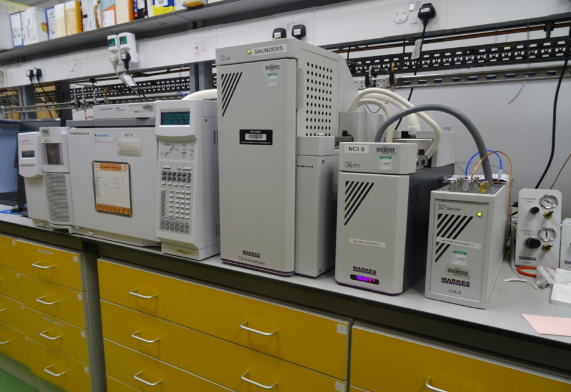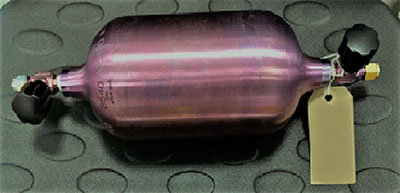NPL can analyse a wide variety of volatile compounds (hydrocarbons, oxygenated hydrocarbons, halocarbons, siloxanes and terpenes) in air sampled from both hyperbaric marine, diving environments and off-gassing from pressurised marine equipment, such as umbilicals. There is a real danger of contaminants in the atmosphere of these hyperbaric environments from paint, thinners and cleaning fluids used during routine maintenance and per iodic refurbishment work and the toxicity of these contaminants is greatly enhanced under pressure. It is therefore essential that these compounds can be detected and measured.
iodic refurbishment work and the toxicity of these contaminants is greatly enhanced under pressure. It is therefore essential that these compounds can be detected and measured.
NPL has more than 15 years’ experience in rapid analysis and reporting the results to check compliance with occupational workplace exposure limits (HSE EH40/2005), occupational exposure limits for hyperbaric conditions (HSE EH75/2) and associated ISO guidelines. NPL has developed methods to identify a wide range of compounds and can perform any or all parts of the full analysis of hyperbaric gas samples:
All of these compounds are quantified using GC-FID analysis and NPL reference materials, prepared in house gravimetrically and traceable to national standards. Compounds with an amount fraction greater than 1 nmol/mol will be reported. Typical uncertainties are 2 - 5 % (k = 2).
Class of compound |
Compounds |
|---|---|
|
Hydrocarbons |
ethane, ethene, propane, propene, i-butane, n-butane, acetylene, trans-2-butene, 1-butene, cis-2-butene, 2-methyl-butane, n-pentane, 1,3-butadiene, trans-2-pentene, 1-pentene, 2-methyl-entane + 3-methyl-pentane, n-hexane, isoprene, n-heptane, benzene, 2,2,4-trimethyl-pentane, toluene, n-octane, tthyl-benzene, m+p-xylene, o-xylene, 1,3,5-trimethyl-benzene, 1,2,4-trimethyI-benzene, 1,2,3-trimethyl-benzene, *i-butylene, *i-heptanes, *unknown C8, *unknown C9, *C9/C10 aromatics |
|
Terpenes |
±α-pinene, ±β-pinene, limonene |
|
Halocarbons |
trichloroethylene, tetrachloroethylene |
* Quantified using the response factor of a similar compound contained in the reference gas mixtures.
All the compounds can be quantified using TD-GC-FID-MS. Samples are transferred to suitable sorbent tubes for this analysis. Calibration is achieved using a multi-point standard calibration derived from gravimetric liquid standards prepared by NPL. Typical uncertainties are 10 - 25 % (k = 2). Unknown compounds will also be reported and identified if possible.
Class of compound |
Compounds |
|
Hydrocarbons |
propyl benzene, 1-ethyl-3-methylbenzene, 1-ethyl-4-methylbenzene, 1-ethyl-2-methylbenzene, 2-methyl-1-hexene, acetonitrile (other), THF (oxygenated hydrocarbons) |
|
Oxygenated hydrocarbons |
acetone, ethanol , 2-methyl-2-propanol, *ethanal (acetaldehyde), methyl acetate, 2-*propenal (acrolein), *2-butenal, *2,3-butanediol, vinyl acetate, ethyl acetate, isopropyl acetate, 1-butanol, butan-2-one (MEK), isopropyl alcohol (IPA), methyl isobutyl ketone (MIBK), 2-butoxyethanol |
|
Halocarbons |
dichloromethane, chloroform, 1,2-dichloroethane |
|
Siloxanes |
*hexamethylcyclotrisiloxane, octamethylcyclotetrasiloxane |
* Quantified using the response factor of a similar compound contained in the liquid standards.
Using GC-TCD with a range of carrier gases and detectors, the composition and make up of balance gases in a diving atmosphere, chamber or tank can be analysed. Presence of other permanent gases that are harmful yet abundant at lower concentrations can also be tested for. Uncertainties are typically under 2 % (k = 2).
Class of compound |
Compounds |
|
Permanent Gases |
carbon monoxide, carbon dioxide, methane, helium, nitrogen and oxygen. |
NPL experts are at hand to provide advice on the best techniques for obtaining representative gas samples and can provide appropriate sample collection cylinders (typically double-ended of 1 litre volume). These are specifically designed for hyperbaric sampling and come with specialist passivation to avoid sample decomposition. Fittings and other connectors can be provided on request.

Don’t see what you are looking for? Our diverse skill set enables us to provide bespoke solutions. Please contact us to discuss your requirements.
Our research and measurement solutions support innovation and product development. We work with companies to deliver business advantage and commercial success.
Contact our Customer Services team on +44 20 8943 7070